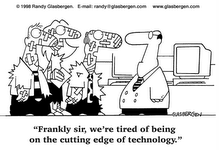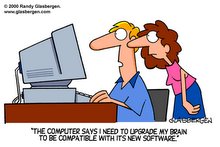Tuesday, January 29, 2008
SOA for SOA's sake
Too many times, we’re engaging in SOA for SOA’s sake. There are many situations were SOA may simply not be necessary. A mainframe system that rapidly processes transactions may be well enough left alone. You’re not going to increase the speed of systems by putting a layer on top of it. SOA success means applying SOA where needed. But if it ain’t broke, don’t fix it. Last month I was at a DoD seminar and one of the speakers said that you don't want to wrap a nuclear bomb system in a layer of SOA. That's good. I am glad the speaker (and hopefully others within DoD) realize this.
What would an economic downturn mean for SOA?
On January 7th, Joe McKendrick posted an interesting question on his blog on zdnet. He asked what an economic downturn might mean for SOA. His post is at: ( http://blogs.zdnet.com/service-oriented/?p=1036 ). He says that with the recent hysteria of doom and gloom over the state of the economy, and while he believes that the economy is resilient, it’s only natural to see ups and downs in business cycles. However, he says that the current incarnation of SOA has only been around during a period of upward economic growth and he contemplates might be the impact of an economic downturn. You can read his post but the gist is that he feels that while some adjustments may need to be made, he and members of his SOA consortium believe that SOA efforts will continue to press on, especially if SOA is closely tied to business value. One industry practice leader said that: In a “downturn, people will have to be more creative, and will turn towards SOA.”
So, in summary, McKendrick suggests that the outlook for SOA for 2008 is quite bullish, no matter how rocky the economy gets. He does suggest, however, that the way SOA is sold to organizations -- as well as implemented -- may shift.
So, in summary, McKendrick suggests that the outlook for SOA for 2008 is quite bullish, no matter how rocky the economy gets. He does suggest, however, that the way SOA is sold to organizations -- as well as implemented -- may shift.
Tuesday, January 22, 2008
how to pick an ESB...
There is a great deal of debate and confusion around SOA and ESB products, so evaluating them for purchase is a challenging proposition. Many vendors, for example, argue that ESB is a product and others an architecture. Some vendors also argue that ESB is not product at all but is a marketing term. ESB is certainly a marketing term, but it does imply a set of functionality to expect, so the term does provide value in categorizing products.
Network Computing magazine recently completed an evaluation of ESB products that provides an interesting perspective. Their evaluation was largely based on development tool capabilities. They did not, for example, do any performance tests. Network Computing ranked BEA Systems Aqualogic Service Bus 2.1 first followed closely by Oracle SOA Suite. The other contenders included TIBCO Software, Fiorano, Cape Clear, IBM, Software AG and Sonic Software. Sonic Software placed last even though they were an early proponent of the ESB concept and marketing strategy.
Network Computing included integration in their evaluation and I agree with this approach. Integration is still a key criterion for evaluation since there are so many legacy systems to wrap as part of SOA. Not surprisingly, the vendors coming from the EAI space did well in this category.
Some of the products did very poorly, which is an indicator of the immaturity in the space. For example, some products had poor administration and debugging tools. Some did poorly in mapping XML to XML, which is surprising since this is such a fundamental feature.
As expected, the large platform vendors continues to place pressure on the pure-play vendors. BEA and Oracle has strong showings with their products. IBM was somewhat limited in the test by the test criteria. For example, they scored poorly in orchestration, but this feature is in a product that was not considered (WBI Process Server). Also, completeness of the product stack (a Gartner magic quadrant measure) was not considered. This measure could have helped IBM and TIBCO. Product performance is also a strong suit for IBM's Message Broker, which was not considered. The evaluation also did not play to Sonics strengths -- either performance or out-of-the-box fault tolerance. Also, the evaluation tested the 6.1 version of Sonic ESB, not the latest version which has had significant improvement. The Network Computing evaluation lacked some critical aspects of evaluation that should be considered, namely:
* The architectural fit with existing platforms and technology
* Completeness of stack - e.g. Business Process Management, Business Activity Monitoring, Portal (these are not ESB products but should be considered for enterprise SOA)
* Product performance
* Fault tolerance
So far, however, in multiple reports, by a variety of organizations, it seems that the strongest ESB product is BEA's. No wonder Oracle has decided to purchase BEA -- for its strong SOA foothold.
I am attending that ESB online conference in 2 days. Then I get to roll that knowledge into my ESB report and get back to real work. :-D
Sun's SeeBeyond product doesn't seem to be anywhere near the same level as all of these other ESB products. If Sun had an competitive ESB product it should be included in the study -- but it looks like they don't.
Cape Clear also seems mostly targeted towards smaller organizations.
Network Computing magazine recently completed an evaluation of ESB products that provides an interesting perspective. Their evaluation was largely based on development tool capabilities. They did not, for example, do any performance tests. Network Computing ranked BEA Systems Aqualogic Service Bus 2.1 first followed closely by Oracle SOA Suite. The other contenders included TIBCO Software, Fiorano, Cape Clear, IBM, Software AG and Sonic Software. Sonic Software placed last even though they were an early proponent of the ESB concept and marketing strategy.
Network Computing included integration in their evaluation and I agree with this approach. Integration is still a key criterion for evaluation since there are so many legacy systems to wrap as part of SOA. Not surprisingly, the vendors coming from the EAI space did well in this category.
Some of the products did very poorly, which is an indicator of the immaturity in the space. For example, some products had poor administration and debugging tools. Some did poorly in mapping XML to XML, which is surprising since this is such a fundamental feature.
As expected, the large platform vendors continues to place pressure on the pure-play vendors. BEA and Oracle has strong showings with their products. IBM was somewhat limited in the test by the test criteria. For example, they scored poorly in orchestration, but this feature is in a product that was not considered (WBI Process Server). Also, completeness of the product stack (a Gartner magic quadrant measure) was not considered. This measure could have helped IBM and TIBCO. Product performance is also a strong suit for IBM's Message Broker, which was not considered. The evaluation also did not play to Sonics strengths -- either performance or out-of-the-box fault tolerance. Also, the evaluation tested the 6.1 version of Sonic ESB, not the latest version which has had significant improvement. The Network Computing evaluation lacked some critical aspects of evaluation that should be considered, namely:
* The architectural fit with existing platforms and technology
* Completeness of stack - e.g. Business Process Management, Business Activity Monitoring, Portal (these are not ESB products but should be considered for enterprise SOA)
* Product performance
* Fault tolerance
So far, however, in multiple reports, by a variety of organizations, it seems that the strongest ESB product is BEA's. No wonder Oracle has decided to purchase BEA -- for its strong SOA foothold.
I am attending that ESB online conference in 2 days. Then I get to roll that knowledge into my ESB report and get back to real work. :-D
Sun's SeeBeyond product doesn't seem to be anywhere near the same level as all of these other ESB products. If Sun had an competitive ESB product it should be included in the study -- but it looks like they don't.
Cape Clear also seems mostly targeted towards smaller organizations.
Thursday, January 3, 2008
Subscribe to:
Posts (Atom)



